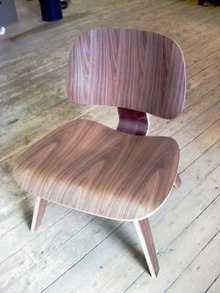Eames Lounge Chair Wood

The Eames Lounge Chair Wood (LCW) (also known as Low Chair Wood or Eames Plywood Lounge Chair) is a chair designed by husband and wife team Charles and Ray Eames, considered to be one of the most influential design teams of the 20th century. This chair is considered their breakthrough.
The chair was designed using technology for moulding plywood that the Eames developed prior to, and during, The Second World War. Previous to the American involvement in the war Charles and his friend, architect Eero Saarinen, entered a line of furniture into the Museum of Modern Art's "Organic Furniture Competition" in 1940. The competition was set up to explore the natural evolution of furniture in response to the rapidly changing world. The entry of Charles and Eero was chosen as the winner of the competition. However, production of the initially designed chairs was postponed due to production difficulties, and then by the United States entry into WWII.
This interruption proved fortuitous to Charles. He began making molded plywood splints for the U.S. Air Force. The splints were modelled after his own leg and allowed him to hone the technique of molding the plywood into complex curves. The LCW was a result of this experience.
Design
Initially Charles had set out to find a solution to providing affordable, comfortable furniture that could be easily mass produced. His entries into the Organic Furniture competition were designed to have the seat and backrest joined in a singe 'shell'. The plywood, however, was prone to crack when bent into the sharp angles and had to be covered with upholstery. Through extensive trial and error Charles and Ray arrived at an alternate solution: create two separate pieces for the seat and backrest, joined by a plywood lumbar support, with plywood legs. The result was a comfortable chair with a sleek and modern appearance. The seat was joined to the lumbar support and legs with a series of four heavy rubber washers with nuts embedded in them (later these came to be called 'shock mounts'). The shock mounts were glued to the underside of the seat, and screwed in through the bottom of the chair. The backrest was also attached using shock mounts. The rubber mounts were pliable, allowing the backrest to flex when the chair is occupied. This was one of the first examples of a chair with a responsive backrest. This unique technology is also one of the chair's greatest flaws. The shock mounts are securely glued to the wooden backrest, but may tear free if excessive pressure is applied, or if the rubber becomes brittle. A common response to this problem was to drill directly through the backrest and insert fasteners between the backrest and the lumbar support. This greatly devalues the chair and mars the original aesthetic of the smooth, uninterrupted wooden forms.
Even though the plywood chair was a compromise of the Eames' vision to create a single shell chair it still constituted a successful design. Following the LCW the Eames created a family of plywood chairs. The all-plywood Dining Chair Wood (DCW) was constructed in the same manner as the LCW, but with a narrower seat, and longer legs. The Lounge Chair Metal (LCM) and Dining Chair Metal (DCM) were constructed of the same plywood seats and backrests as the LCW & DCW set on a welded metal frame.
Coming out of an age where furniture was heavy and complex; made from multiple materials and then covered in upholstery, the Eames design was a refreshing new way of looking at furniture and furniture design. The chair was produced in a short run by Evans Moulded Plywood of Venice Beach, California for Herman Miller furniture company. Herman Miller later absorbed the production of the chairs and has continued producing them until present day (a brief period existed when the chairs were out of production). In Europe, Vitra became the producers of Eames furniture. These are the only two companies producing chairs licensed by the Eames estate as represented by the Eames Office.
Collectable
The chair continues to be an icon of Modern Design style. It is valued for its comfort as well as its status symbol. Original production models are highly valued by collectors. The chair was initially offered in 3-4 natural wood veneers such as ash, walnut, and cherry. It was also offered in two aniline dyed colors: ebony black, and red. The value of these chairs to collectors depends on many variables. Generally speaking chairs that are in true original condition are valued the highest, especially those from the earliest production by Evans Co, with red being the most desirable. Modifications to the backrest, damages to the veneer, and excessive wear will reduce value.
